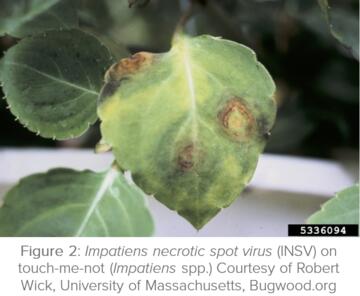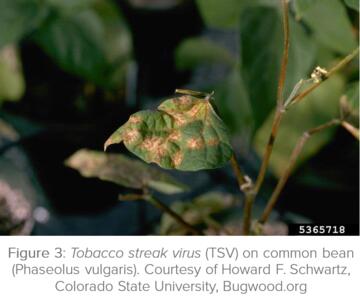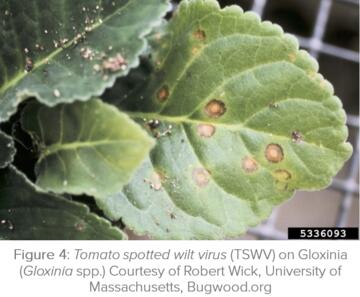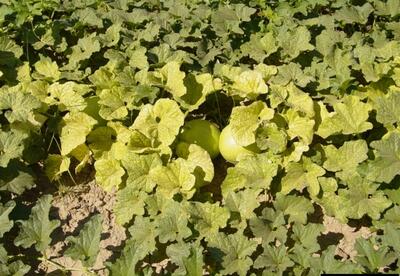
Figure 1. The new Thrips Spot Viruses ImmunoComb® for convenient detection of INSV, TSV and TSWV.
Agdia, Inc. is happy to announce the addition of a new product to their ImmunoComb® line to help growers detect and combat plant viruses that cause similar symptoms in addition to sharing a common insect vector. The new Thrips Spot Viruses ImmunoComb® brings together three existing ImmunoStrips® in one easy-to-use format.

Impatiens necrotic spot virus (INSV, Orthotospovirus) is an enveloped and spherical-shaped virus that infects over 600 plant species. While the virus is primarily spread by western flower thrips (WFT), it can also spread effectively via cuttings (vegetative propagation). From entire fields of lettuce in the Southwest to widespread distribution of infected African Violet cuttings on the East Coast, INSV outbreaks have covered much of the United States in recent years.
Symptoms of INSV infection vary by host, but often include brown, purple or sunken spots on leaves, brown spots on stems, chlorosis, necrosis, stunting and ringspots.
Tobacco streak virus (TSV, Ilarvirus) has a wide host range consisting of nearly 200 plant species, causing significant economic losses in crops ranging from dahlias and other ornamentals to vegetable and field crops.

Tomato spotted wilt virus (TSWV) is another member of the Orthotospovirus genus capable of infecting many different crops of economic significance. According to the Centre for Agriculture and Biosciences International (CABI), TSWV is now considered to be among the top 10 “most economically destructive plant viruses with worldwide losses exceeding 1 billion dollars annually.” It is spread by several different species of thrips. Symptoms include (but are not limited to) small brown spots or flecks, ring spots, chlorosis, necrotic patches and more.
The Thrips Spot Viruses ImmunoComb® for INSV, TSV and TSWV allows growers to conveniently and simultaneously detect or rule out infections of each virus in a single sample. This product is sold in kits of 8 combs consisting of 3 ImmunoStrips® each, and kits include the buffer-filled extraction bags necessary to perform a test. Agdia provides a one-year warranty on all purchased products along with an unrivaled level of customer support.
About Agdia
A leading provider of diagnostic solutions for agriculture, Agdia, Inc. has been serving plant breeders, propagators, growers, universities, and private testing laboratories since 1981. The company offers a comprehensive portfolio of validated, easy-to-use diagnostics for identifying plant pathogens, hormones, and transgenic traits. In addition, Agdia operates an ISO accredited, in-house, testing services laboratory. Agdia’s quality management system is ISO 9001:2015 certified and their Testing Services Laboratory is ISO 17025:2017 accredited. Visit the company’s website at www.agdia.com, e-mail info@agdia.com, phone 1-574-264-2615 (toll-free 800-622-4342) or fax 1-574-264-2153.
ImmunoStrip® and ImmunoComb® are registered trademarks of Agdia, Inc
Acknowledgements: Thank you to Robert Wick (University of Massachusetts, Bugwood.org) for providing Figures 2 and 4, and to Howard F. Schwartz (Colorado State University, Bugwood.org) for providing Figure 3.






